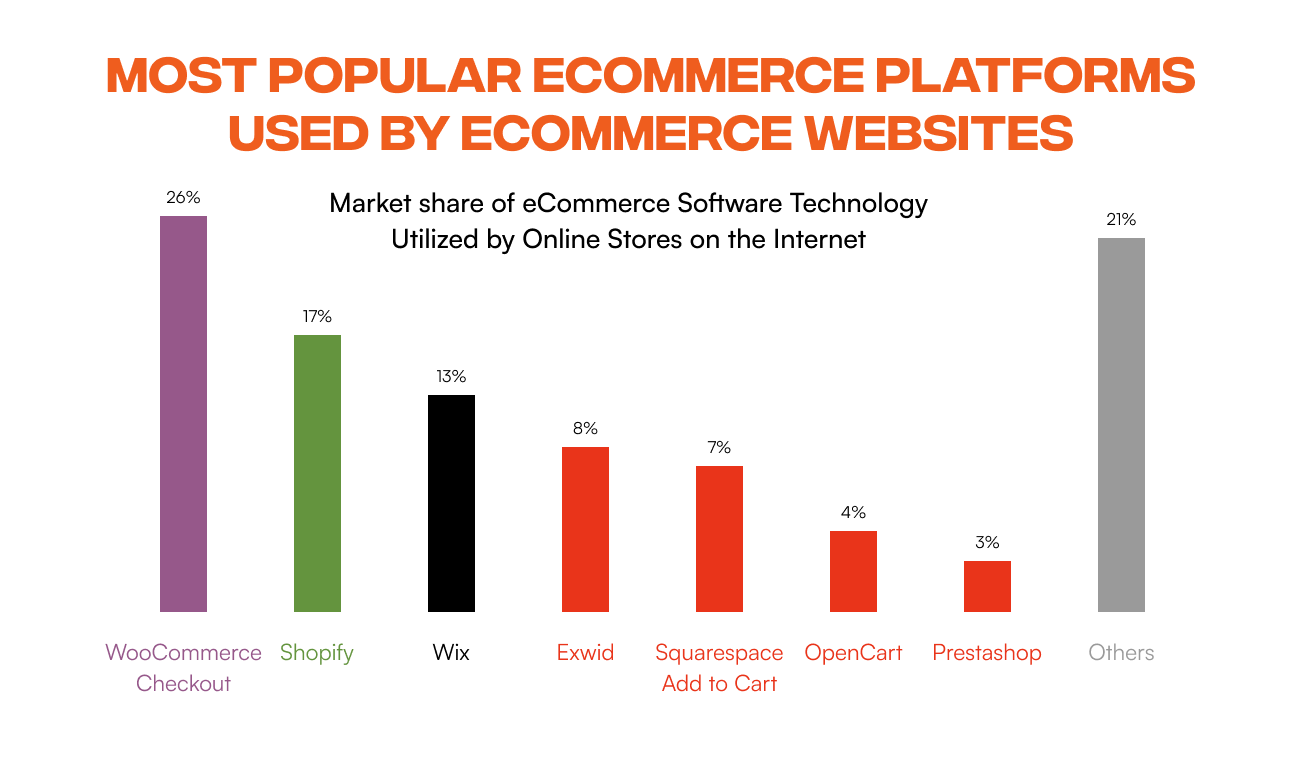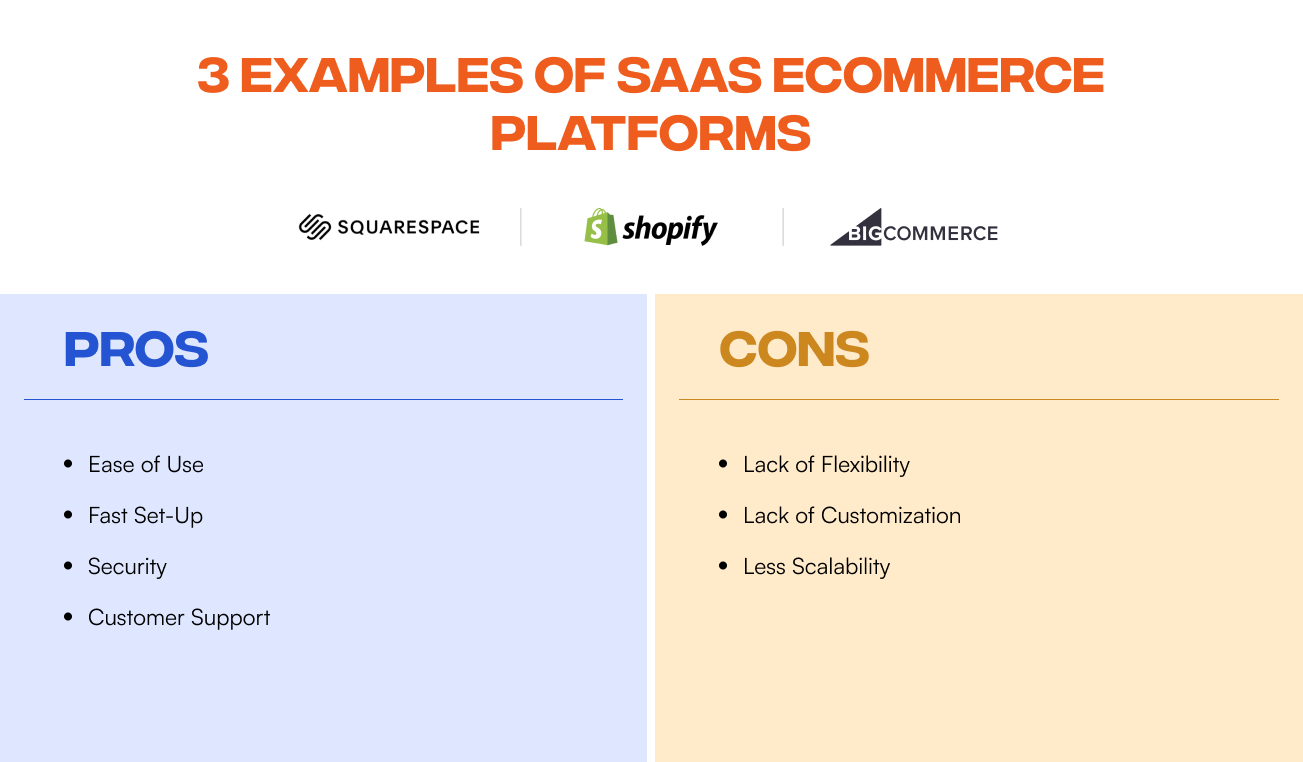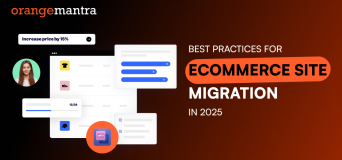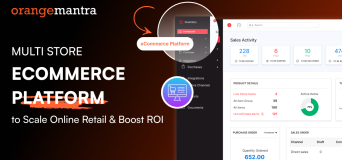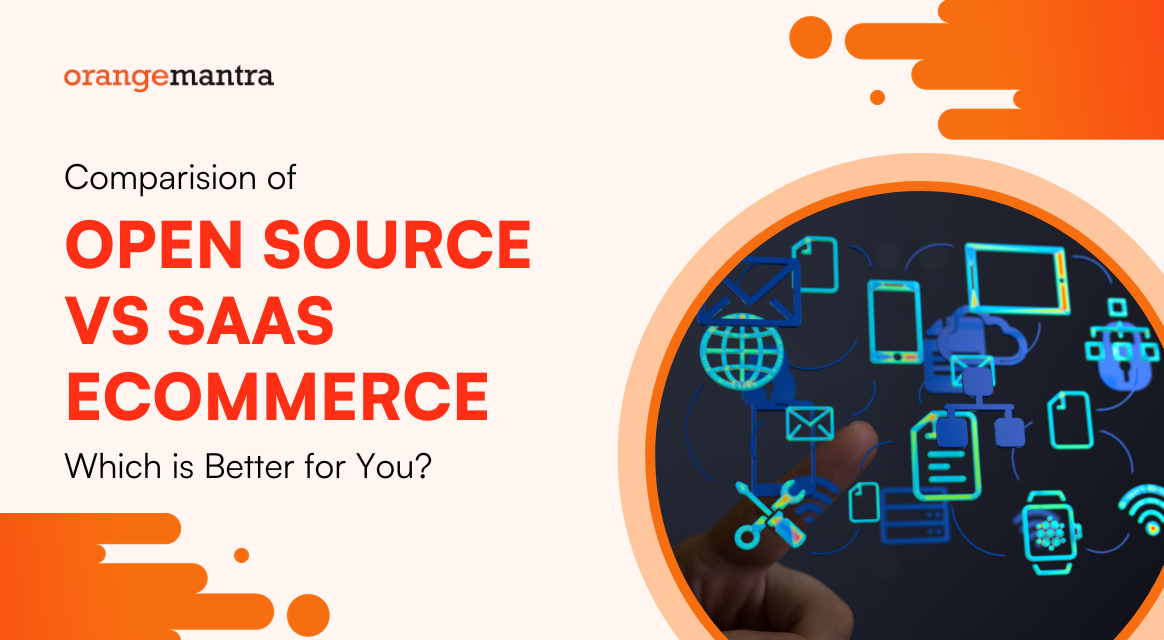
Here’s what you will learn:
Table of Contents
Introduction
You ought to choose the right eCommerce platform to create a strong backbone for your online retail store. It’s when you need to consider an ideal choice between Open Source vs SaaS eCommerce and create a feature-rich store.
Starting your eCommerce journey might appear simple. Hire eCommerce consulting services to acquire the right guidance to know about products to add, update descriptions, and pricing, and that’s it.
By going this way, you might think you are good to go with eCommerce business. Well, that’s not thing go in a straightway.
Just like, every eCommerce business has a different set of requirements in terms of features, functionalities, analytics, and integrations. Similarly, choosing the best B2C or B2B eCommerce marketplace solution, whether open source or software-as-a-service (SaaS) is important to ensure rapid business growth.
Selecting the right eCommerce platform means running a successful and profitable online retail business for years. It will help you keep extending your store’s functionalities and features with changing time intervals, and stay ahead of the competition.
So, with the help of our informative blog, know the real-time difference between open source vs eCommerce SaaS platform. That, too is based on the following key points.
Let’s get started on the same.
What is an Open Source eCommerce Platform?
An open-source eCommerce platform means you will get full access to the source code. It simplifies, custom eCommerce development is flexible on your part and you have the freedom to create any functionality along with adding specific features.
In short, doing customization is simple with an open-source eCommerce platform. But the way it appears simple at first it isn’t. You need to have the expertise of eCommerce developers to do the specific additions and changes.
List of Popular Open Source eCommerce Platforms
Consider any of the following open-source eCommerce platforms to get started with your online retail business.
- Magento: Also, known as Magento eCommerce platform, it’s one of the platform open-source platforms. By covering a market share of 2.35% of total eCommerce stores all across the world, with the help of Magento support and maintenance small, medium, to large-scale business owners are starting and extending online retail stores with ease and comfort.
- Drupal: It is another open-source and one of the popular eCommerce platforms that covers more than 35.50% of the total market share. Best meant to help large enterprises for the purpose of creating complex eCommerce stores at low cost.
- OpenCart: The fully functional and feature-rich OpenCart eCommerce solutions are another viable choice you have. It offers a stronghold analytics feature to analyze the performance of your online store. And, make specific altercations to boost sales patterns.
- WooCommerce: A WordPress-based eCommerce development extension, WooCommerce offers you open-source accessibility and easily customize the store. With the assistance of a WooCommerce development agency, get a seamless Content Management System (CMS) of WordPress to best manage your store.
- PrestaShop: PrestaShop eCommerce development company in India allows you add required to complex features to your eCommerce store and stay unique among competitors. It’s an ideal platform, especially for simple inventory management.
What is SaaS eCommerce?
A subscription-based software-as-a-service eCommerce platform allows you to create an instant store with everything on the cloud with secured protocols. Compared with open-source eCommerce platforms, SaaS runs on monthly or yearly subscription fees. The fee that you pay for SaaS eCommerce development services includes domain, hosting, development, maintenance, and more. A SaaS-based eCommerce platform allows you access ready-to-use features to create and successfully run your store. Lastly, hire SaaS development experts to set up, install, and maintain your eCommerce store with easy accessibility.
Also read – eCommerce Frameworks and Their Practical Business Applications
List of Popular SaaS eCommerce Platforms
When it comes to selecting the pay-as-you-go service model of a SaaS-based eCommerce platform, considering the following options.
- SquareSpace: More of an ERP (Enterprise Resource Planning) software that helps you create an eCommerce store along with managing inventory, and other functionalities.
- Shopify: Rely on one of the popular SaaS eCommerce platforms like Shopify eCommerce development and utilize drag-and-drop features to create customized functionalities.
- BigCommerce: Another big name to consider is BigCommerce. Another open-source eCommerce platform that allows you website designing, development, to CRM functionalities to an optimum extent.
Difference Between Open Source and SaaS eCommerce Platforms
In order to compare open source vs SaaS eCommerce, it is essential to various factors. The functioning of the respective eCommerce model is not enough to tell you the difference. Therefore, you need to know the open source and SaaS eCommerce abilities, cost, and reach, before deciding on an apt choice.
Cost of Ownership
The cost of Open Source and SaaS eCommerce platforms depends on the manifold factors.
Open Source
- Licensing Cost: Open Source eCommerce software is both free (with limited functional capabilities) and paid (with an additional set of features and integrations). So, the initial cost of licensing depends on your requirement, whether to go for free or paid version.
- Hosting Price: The hosting cost includes hardware, network, technical maintenance, and other prices that you have to bear. Depending on the size of your eCommerce business and the space required for the digital space, the hosting cost may vary.
- Development Cost: The cost of Magento, Drupal, or any other eCommerce development relies on your business requirements. Even the level of customization will decide how much you need to pay for.
SaaS (Software-as-a-Service)
- Subscription Cost: The software-as-a-service eCommerce platform requires you to pay the monthly subscription fee. In a better way, you rent the eCommerce platform including the hosting, database, network, storage, and other things on a monthly basis. Once again, the scale of your online retail business will decide how much to pay for the monthly subscription.
- Cost of Paid Themes & Upgrades: The cloud-based eCommerce software features paid themes and upgrades. Depending on your requirements, pay for specific themes.
- Paid Integrations & Extensions: Customization is the key benefit of SaaS eCommerce. Depending on the level of customization, you can decide to pay for paid integrations and extensions.
Setup & Installation
Next, a factor to differentiate between open source and SaaS eCommerce is the process of setting up and installing a particular platform.
Open Source: Simple process to download the open-source eCommerce platform, install, and setup free of cost:
SaaS: First start with the free trial to set up the eCommerce platform and get used to it within a short time span. Following that pay the subscription fee to get started.
User-friendly Appeal
- Open source: As an eCommerce site owner, you ought to hire the service of an expert custom eCommerce software development Company in India. Professional eCommerce developers will help you get the initial gist of using the platform. However, you may need further professional assistance for inventory management, warehouse management, adding more functionalities, etc.
- SaaS: The software-as-a-service eCommerce platform functions based on different third-party applications. As a user, you can integrate the required applications with the least technical knowledge. Still, the initial phase requires you to hire an eCommerce expert to know the things.
Design & Customization
- Open source: The open-source eCommerce software features a basic design, same for all online retailers. Thus, customization is required to add a preferred choice of design elements, visuals, and other things.
- SaaS: The third-party cloud-based eCommerce software has a design by default. It’s difficult to make the custom design changes. Despite that, there is flexibility to add the required choice of functionalities.
Site Security & Compliance
- Open source: Pick your own security tool and functionality to safeguard the eCommerce store.
- SaaS: The SaaS-based service providers are themselves responsible for securing the platform and updating the required protocols.
Pros & Cons of Open Source and SaaS eCommerce
Let’s just quickly get into the pros and cons of choosing an open source vs SaaS eCommerce platform. Definitely, it’s all based on your business requirement and budget to opt for one option. Still, each technology has its two sides. Similarly, both options have advantages and disadvantages.
Pros of Open Source
- For startups, open-source is an apt choice to reduce the initial level development and setup cost.
- Flexibility to utilize a wide variety of open-source tools and functionalities.
- Get access to an active community of developers and experience round-the-clock technical support.
Cons of Open Source
- Utmost need to hire open-source eCommerce platform experts to do the development for you. Fortunately, several reliable eCommerce development companies in India are available to help you.
- Need good financial investment for customization. The better you want the store to be customized, spend more on the development part.
Pros of SaaS
- Easy to sign up and choose from a wide range of subscription models based on your budget.
- Get real-time software upgrades, timely maintenance, and security updates from the service provider, and that too without incurring additional costs.
- Better than self-hosted options due to service provided by reliable experts and top-notch companies.
Cons of SaaS
- Pay monthly, quarterly, or yearly fees that might rise with changing intervals.
- Initially, you might experience a limited set of functionalities.
Final Verdict
Selecting the right type of eCommerce platform is important for your business. It’s a relevant decision to make based on your budget and functional requirements. Undoubtedly, open source and SaaS eCommerce have their pros and cons to look into the same. Therefore, it is important to evaluate the good and bad sides of each option, before selecting the right one.
For better assistance and in-depth information, get in touch with an industry-expert eCommerce website development company, like, OrangeMantra. One of the leading digital transformation and business acceleration companies can help you develop a profitable eCommerce store with single-based and omnichannel retail solutions. Mainly by selecting the right eCommerce platform choice.
Frequently Asked Questions
Q1. Which is better for us open source or SaaS eCommerce?
Ans. Choosing the right eCommerce platform, whether open source or cloud-based depends on your budget, scale of business, and requirements. It is essential to obtain professional advice to know which platform is suitable for your business to make substantial profits ahead.
Q2. In how much time to develop a particular eCommerce platform?
Ans. It again depends on your business requirements. Depending on the selected choice of features, functionalities, and customizations, the timeline will be decided by an expert eCommerce development agency.
Q3. Is open source eCommerce platform scalable?
Ans. Yes, it’s simple to scale up functionalities, design elements, storage, and other things in your selected open-source eCommerce platform. All that is required is the professional assistance of an expert expert company like us.
Q4. Can SaaS be open source?
Ans. No, software-as-a-service cannot be open source in nature. Only the free trial is open source and that too for a limited duration. After the free trial is over, you ought to pay the subscription fee to fully access SaaS eCommerce.
Q5. How can you help us choose the right platform?
Ans. We fully assist you in selecting the result-oriented eCommerce platform. After understanding your business model and target audience, we suggest you an apt eCommerce software to go with. Following that, we help you develop the platform from scratch.
